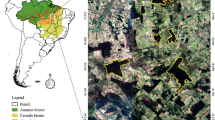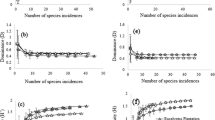Abstract
Studies of seasonal dynamics of the activity of ants were carried out in July–August of 2013–2015 in broadleaf forests (Kyiv, Ukraine. Transects were located within foraging areas of three dominant species Formica rufa L., Lasius fuliginosus (Latreille), and L. emarginatus (Olivier). Thirteen species of ants were encountered on the soil surface. Factors that influence the activity of ants in forests may be ranked by importance as follows. (1) Climatic factors: (a) air temperature and soil humidity; (b) mean monthly rainfall; (c) air humidity. (2) Phytogenic factor (tree species composition). 3. Interspecific hierarchy of ants (primarily, territoriality of the dominant species).
Similar content being viewed by others
References
Ayre, G.L., “Some Meteorological Factors Affecting the Foraging of Formica subnitens Creighton,” Insectes Sociaux 5 (2), 147–157 (1958).
Bestelmeyer, B.T. and Wiens J.A., “The Effects of Land Use on the Structure of Ground-Foraging Ant Communities in the Argentine Chaco,” Ecological Applications 6, 1225–1240 (1996).
Bugrova, N.M., “The Impact of Forest Area Fragmentation on Ant Population,” Entomological Review 90 (5), 541–547 (2010).
Cerdá, X., “Behavioural and Physiological Traits to Thermal Stress Tolerance in Two Spanish Desert Ants,” Etologia 9, 15–27 (2001).
Cerdá, X., Retana, J., and Cros, S., “Critical Thermal Limits in Mediterranean Ant Species: Trade-off between Mortality Risk and Foraging Performance,” Functional Ecology 12, 45–55 (1998).
Czechowski, W., Radchenko, A., and Czechowska, W., The Ants (Hymenoptera, Formicidae) of Poland (Museum and Institute of Zoology, Polish Academy of Sciences, Warsaw, 2002).
Czechowski, W., Radchenko, A., Czechowska, W., and Vepsäläinen, K, Fauna Poloniae (New Series). The Ants of Poland with Reference to the Myrmecofauna of Europe (Natura Optima Dux Foundation, Warsaw, 2012).
Dlussky, G.M., “The Thermal Regime in the Nests of Some Species and Evolutionary Pathways of Thermoregulation in Ants of the Genus Formica,” Fiziologicheskaya i Populyatsionnaya Ekologiya Zhivotnykh 6 (8), 13–36 (1980).
Dlussky, G.M., Desert Ants (Nauka, Moscow, 1981) [in Russian].
Gallé, R., Torma, A., and Maák, I., “The Effect of Forest Age and Habitat Structure on the Ground-Dwelling Ant Assemblages of Lowland Poplar Pantations,” Agricultural and Forest Entomology 18 (2), 151–156 (2016).
Goncharenko, I.V., Ignatyuk, O.A., and Shelyag-Sosonko, Yu.R., “Forest Vegetation of Natural Landmark “Feofaniya” and Its Anthropogenic Transformation,” Ekologiya ta Noosferologiya 24 (3-4), 51–63 (2013).
Holec, M. and Frouz, J., “Ant (Hymenoptera: Formicidae) Communities in Reclaimed and Unreclaimed Brown Coal Mining Spoil Dumps in the Czech Republic,” Pedobiologia 49, 345–357 (2005).
Holt, S.J., “On the Foraging Activity of the Wood Ant,” Journal of Animal Ecology 24, 1–34 (1955).
Klimenko, Yu.O., Moroz, V.V., Druzhinina, M.M., and Kondratyev, V.V., “Assessment of the Condition of Populations of Major Park-Forming Species in a Century-Old Querceta roboris of “Feofaniya” Park (City of Kyiv),” in Scientific Reports of the National University of Bioresources and Nature Management of Ukraine Vol. 5 (online document, http://nbuv.gov.ua/UJRN/ Nd_2015_5_27, 2015). [in Ukrainian]
Kupyanskaya, A.N., Ants of the Far East of the USSR (Far Eastern Branch of the Academy of Sciences of the USSR, Vladivostok, 1990), 260 p. [in Russian]
Lessard, J.-P., Dunn, R.R., and Sanders, N.J., “Temperature-Mediated Coexistence in Temperate Forest Ant Communities,” Insectes Sociaux 56 (2) 149–156 (2009).
Levings, S.C., “Seasonal, Annual, and among Site Variation in the Ground Ant community of a Deciduous Tropical Forest: Some Causes of Patchy Species Distribution,” Ecological Monographs 53, 435–455 (1983).
Mershchiev, A.V., Candidate’s Dissertation in Biology (Moscow State Forest University, Moscow, 2010).
Otto, D., Die Neue Brehm-Bucherei 293. Die Roten Waldameisen (A. Ziemsen Verlag, Wittenberg—Lutherstadt, 1962) [in German]
Punttila, P., Haila, Y., Pajunen, T., and Tukia, H., “Ant Communities in Taiga Clearcuts: Habitat Effects and Species Interactions,” Ecography 19, 16–28 (1996).
Quinet, Y. and Pasteeis, J.M., “Spatial Specialization of the Foragers and Foraging Strategy in Lasius fuliginosus (Latreille) (Hymenoptera, Formicidae),” Insectes Sociaux 43, 333–346 (1996).
Reznikova, Zh.I., Interspecific Relationships in Ants (Nauka, Novosibirsk, 1983) [in Russian]
Santini, G., Tucci, L., Ottonetti, L., and Frizzi, F., “Competition Trade-offs in the Organization of a Mediterranean Ant Assemblage,” Ecological Entomology 32, 319–326 (2007).
Seima, F.A., Structure of Taiga Ant Assemblages (Perm State University, Perm, 2008) [in Russian]
Skinner, G.J., “Territory, Trail Structure and Activity Patterns in the Wood-Ant, Formica rufa (Hymenoptera: Formicidae) in Limestone Woodland in North-West England,” Journal of Animal Ecology 49, 381–394 (1980).
Soboleva, N.I., “Trail System in Red Wood Ants (Formica rufa Group) under Recreation Press,” Entomological Review 91 (2), 189–197 (2011).
Stukalyuk, S.V., “Daily Activity of Ants (Hymenoptera, Formicidae) in Multispecies Associations of Mountainous Crimea,” Trudy Russkogo Entomologicheskogo Obshchestva 84 (2), 114–128 (2013).
Stukalyuk, S.V., “Changes in the Structure of Ant Assemblages in Broad-Leafed Forests with Domination of Impatiens parviflora DC. (Balsaminaceae) in Herbaceous Layer,” Rossiiskii Zhumal Biologicheskikh Invazii, 3, 101–117 (2016) [Russian Journal of Biological Invasions 7 (4), 383–395 (2016)].
Stukalyuk, S.V., “Interactions of Three Dominant Ant Species, Lasius emarginatus (Ol.), Formica rufa L., and Lasius fuliginosus (Latr.) (Hymenoptera, Formicidae) among Themselves and with Subordinate Species of Ants in Broadleaf Forests. Communication 1,” Entomological Review 97 (6), 747–767 (2017a).
Stukalyuk, S.V., “Stratification of the Ant Species (Hymenoptera, Formicidae) in the Urban Broadleaf Woodlands of the City of Kiev,” Entomological Review 97 (3), 320–343 (2017b).
Sudd, J.H. and Sudd, M.E., “Seasonal Changes in the Response of Wood-Ants (Formica lugubris) to Sucrose Baits,” Ecological Entomology 10, 89–97 (1985).
Traniello, J.F., “Foraging Strategies in Ants,” Annual Review of Entomology 34, 191–210 (1989).
Van Oudenhove, L., Billoir, E., Boulay, R., Bernstein, C., and Cerda, X., “Temperature Limits Trail Following Behaviour through Pheromone Decay in Ants, Naturwissenschaften 98, 1009–1017 (2011).
Van Oudenhove, L., Boulay, R., Lenoir, A., Bernstein, C., and Cerda, X., Substrate Temperature Constrains Recruitment and Trail Following Behavior in Ants, Journal of Chemical Ecology, 38, 802–809 (2012).
Vele, A., Holusa, J., and Frouz, J., “Ecological Requirements of Some Ant Species of the Genus Formica (Hymenoptera, Formicidae) in Spruce Forests,” Journal of Forest Science 55 (1), 32–40 (2009).
Wang, C., Strazanac, J.S., and Butler, L., “Association between Ants (Hymenoptera: Formicidae) and Habitat Characteristics in Oak-Dominated Mixed Forests,” Environmental Entomology 30, 842–848 (2001).
Wellenstein, G., “Ergebnisse 25-jahriger Grundlagenforschung zur forstlichen Bedeutung der roten Waldameise (Formica rufa L.),” Mitteilungen aus der Biologischen Bundesanstalt für Land- und Forstwirtschaft 75, 125–133 (1953).
Zakharov, A.A., Organization of Communities in Ants (Nauka, Moscow, 1991) [in Russian]
Zakharov, A.A., Ants of Forest Communities (KMK, Moscow, 2015) [in Russian].
Zakharov, A.A. and Goryunov, D.N., “General Methods for Field Ecological Studies,” in Ants and Forest Protection. Proceedings of the XIII All-Russia Myrmecological Symposium (Nizhny Novgorod State University, Nizhny Novgorod, 2009), pp. 247–255 [in Russian].
Author information
Authors and Affiliations
Corresponding author
Additional information
Original Russian Text © S.V. Stukalyuk, 2017, published in Entomologicheskoe Obozrenie, 2017, Vol. 96, No. 4, pp. 737—751.
Rights and permissions
About this article
Cite this article
Stukalyuk, S.V. The Effect of Climatic Factors on the Activity of Ants (Hymenoptera, Formicidae) in Broadleaf Forests of Kiev. Communication 2. Entmol. Rev. 97, 1234–1243 (2017). https://doi.org/10.1134/S0013873817090056
Received:
Published:
Issue Date:
DOI: https://doi.org/10.1134/S0013873817090056




